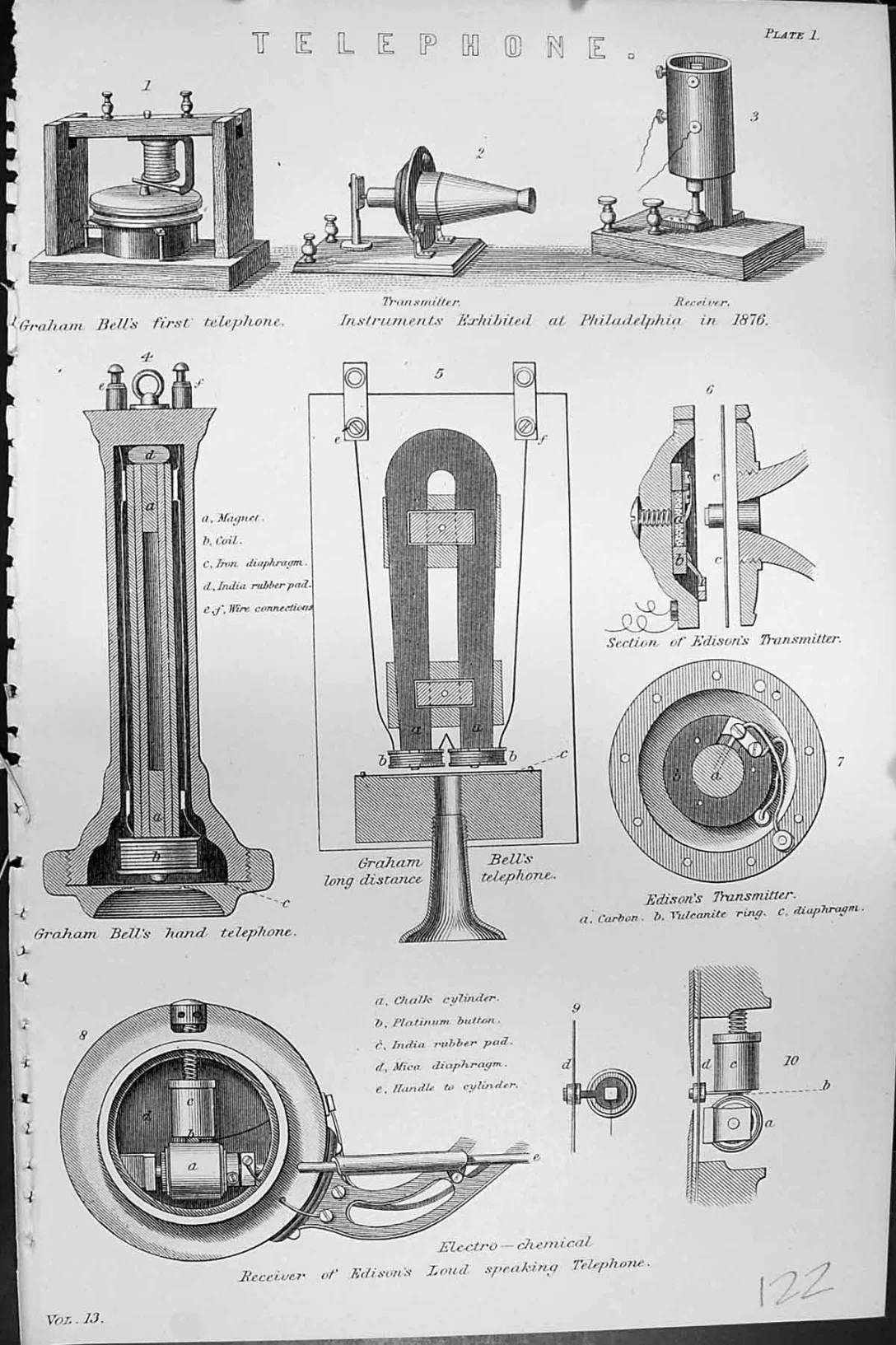[Previous Part] The telephone was an accident. Whereas the telegraph networks of the 1840s emerged out of a century-long search for the means to communicate by electricity, men only stumbled over the telephone while searching for a better telegraph. For this reason, it is easier to pin down a plausible, though not incontrovertible, date for the invention of the telephone – the American centennial year of 1876.
This is not to say that the centennial telephone was without precursors. From the 1830s onward, scientific investigators were exploring ways to turn sound into electricity, and electricity into sound.
Electrical Sound
In 1837, Charles Page, a Massachusetts physician and electrical experimenter, discovered an odd phenomenon. He placed an insulated helical wire between the arms of a permanent magnet, then placed each end of that wire into cups of mercury connected to a battery circuit. Each time he opened or closed the circuit by lifting one wire from its cup or dropping it back in, the magnet emitted a tone audible from as much as three feet away. Page called this galvanic music, and theorized that it was caused by a “molecular derangement” in the magnet.1 Page set off a wave of scientific investigations into two aspects of his discovery: the underlying and rather bizarre fact that ferrous materials change their shape when magnetized, and the more overt phenomenon, the production of sound by electricity.2
For the purposes of our story, two of these investigations are especially interesting. First were those of Philip Reis. Reis taught math and science to school boys at Garnier’s Institute, outside Frankfurt, but spent his spare time on his own electrical researches. Several electricians had by this time composed new variations on galvanic music, but Reis was the first to master the dual alchemy of translating sound into electricity and then back again.
Reis realized that a diaphragm like the human eardrum could be caused to make and break an electric circuit as it vibrated. The first prototype of his telephon (far-speaker), built in 1860, consisted of a carved wooden ‘ear’ with a membrane made from a pig’s bladder stretched across it. Attached to the underside of the membrane was a platinum lead that would open and close a battery circuit as it vibrated. The receiver was a coil of wire wound about a knitting needle, sitting atop a violin. The violin’s body amplified the vibration from the changing shape of the needle as it was magnetized and demagnetized.3
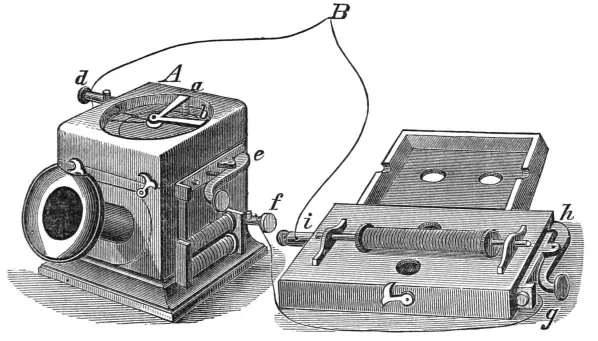
Reis made numerous refinements to this early prototype, and he and others who tried it found that by singing or humming into it, they could transmit recognizable tunes. Words presented more difficulty, and often came across garbled or indistinct. Many of the reports of successful voice transmission involve simple commonplaces such as “good morning” or “how are you”, which might have easily been guessed. The fundamental problem was that Reis’ transmitter only opened and closed the circuit, it did not vary its strength. This allowed it to reproduce the frequency of a sound but at a fixed amplitude, which could not model all the subtleties of the human voice.4
Reis thought his work deserving of serious scientific recognition, but never got it. His device was a popular curiosity among the scientific elite, and copies found their way to most of the major centers of that elite: Paris, London, Washington D.C. But his scientific paper on its workings was rejected by Poggendorff’s Annalen, the premier physics journal of the time, and his efforts to promote it with the telegraph authorities also failed. He suffered from tuberculosis, which, as it worsened, prevented him from further serious work. In 1873 it finally claimed his life as well as his ambition. This is not the last time that this disease will haunt the story of the telephone.5
Around the same time that Reis was refining his telephon, Hermann von Helmholtz was putting the final touches on his seminal study of auditory physiology: On the Sensations of Tone (Lehre von der Tonempfindungen), published in 1862. Then a professor at the University of Heidelberg, Helmholtz was a giant of nineteenth-century science, making contributions to the physiology of vision, electrodynamics, thermodynamics, and more.
Helmholtz’ work is only tangentially connected to our story, but too fascinating to pass by. In On The Sensations of Tone Helmholtz in effect did for music what Newton did for light – he showed how an apparently unitary sensory perception can be decomposed into component parts. He proved that differences in timbre, between the hum of a violin and the drone of a bassoon, come merely from differences in the relative strength of their overtones (tones at double, triple, etc. the frequency of the base note). But for our purposes the most interesting part of this work is the remarkable instrument that he designed for this demonstration:
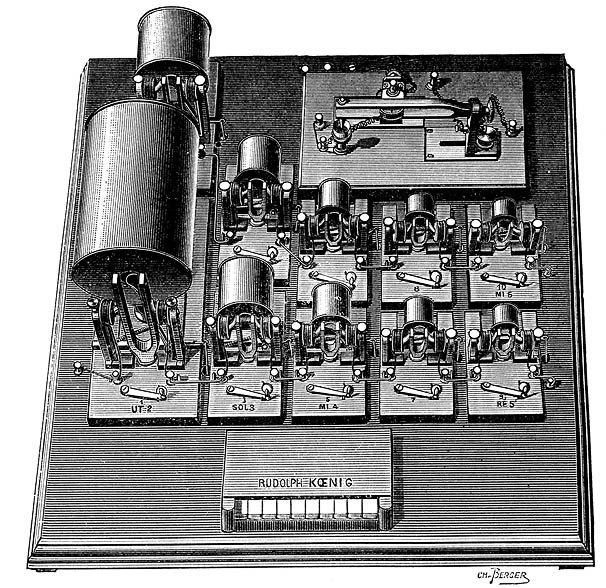
Helmholtz had the first of these devices made at a workshop in Cologne. It was, simply put, a synthesizer, which could generate sounds from the composition of simple tones. 6 Its most striking feature was the uncanny ability to replicate the vowel sounds that one normally heard only from human mouths.
The synthesizer was driven by the pulse of a master tuning fork, vibrating at the base tone, which alternately opened and closed a circuit by dipping a platinum wire in a cup of mercury. Eight magnetized tuning forks, each tuned to a different overtone, rested between the arms of an electromagnet connected to that circuit. Each closing of the circuit turned on the electromagnets, keeping the magnetized forks humming. Next to each fork sat a cylindrical resonator, which could amplify its hum to an audible level. A lid at the far end normally closed the resonator, muffling the sound of its corresponding fork. By sliding open the lids to various degrees, one could alter the volume of each overtone, and thus ‘play’ the sound of a trumpet, a piano, or the vowel ‘o’.7
This device would play a bit part in the creation of a new kind of telephon.
Harmonic Telegraphy
One of the great lures to inventors in the latter half of the nineteen century was multiple telegraphy. The more telegraphic signals one could figure out how to squeeze onto a single wire, the more efficiently the telegraph network could be used. Several different methods of duplex telegraphy (sending two signals in opposite directions at the same time) were extant by the early 1870s. Shortly thereafter, Thomas Edison went one better with the quadruplex, which combined duplex and diplex (sending two signals in the same direction at the same time) to share a single wire four ways.
But could one go further with the multiplexing of signals? What about an octruplex, or beyond? The fact that sound waves and electric currents were mutually interchangeable offered an intriguing possibility. What if one could use tones of varying pitch to make an acoustic, harmonic, or, most poetically, musical telegraph? If physical oscillations of varying frequencies could be translated into electrical ones, then split back out into the original frequencies on the other side, then one could send many signals simultaneously without interference. The sound itself was merely a means to an end, an intermediate medium that happened to shape the currents so as to allow multiple signals to coexist on a single wire. For simplicity I will refer to this concept as the harmonic telegraph, though some variety in terminology was used at the time.
This was not the only road to multiplexing. In France, Emile Baudot had by 1874 devised a machine with a rotating distributor that would pick up signals from a series of telegraphic transmitters in turn. (What we would now call time-division multiplexing, as against frequency-division).8 But that approach has the singular disadvantage, from our perspective, of being very unlikely to lead to telephony.
By this time the dominant name in American telegraphy was Western Union, a combination that had formed in the 1850s in order to eliminate the mutually-damaging competition among several large telegraph companies – prior to federal anti-trust laws, there was no difficulty in nakedly justifying a merger on this basis. One of the protagonists of our story rated it as “probably the largest corporate body that has ever existed.”9 With its thousands of miles of wire and the great expense required to build and maintain them, Western Union eyed any developments in multiple telegraphy with a keen interest.
There was another party also on the lookout for advances in telegraphy. Gardiner Hubbard, a Boston lawyer with an entrepreneurial bent, was among the chief proponents of an ongoing effort to put American telegraphy under the control of the federal government. Hubbard believed that telegrams could be delivered as cheaply as letters, and was determined to undermine what he saw as Western Union’s cynical and extortionate monopoly. The “Hubbard Bill” would not have explicitly nationalized the existing telegraph companies, as most European governments had, but instead would have established a government-chartered telegraph service under the auspices of the Post Office. The end result, putting Western Union out of business, would likely have been the same. By the mid-1870s the bill had stalled, but Hubbard knew that control of a crucial new telegraph patent might give him the leverage to finally push his proposal through Congress.10
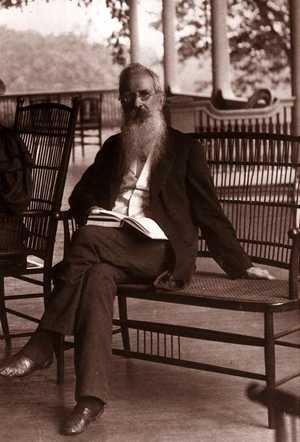
There were two factors here unique to the U.S.: First, Western Union’s continental scale. No European telegraph authority had such long lines, and thus so much incentive to pursue multiple telegraphy. Second, the still open question of government control of the telegraph. The last holdout in Europe was Britain, which nationalized its telegraph system in 1870. Thus nowhere else was there the tantalizing possibility of a technological breakthrough that could undermine the incumbent. It is probably for these reasons that the majority of the work on harmonic telegraphy happened in the U.S.
There were three primary contenders for the prize. Two were already accomplished inventors – Elisha Gray and Thomas Edison. The third was a professor of elocution and teacher of the deaf named Bell.
Gray
Elisha Gray came of age on a farm in Ohio. Like many of his contemporaries, he tinkered with telegraphy in his boyhood, but after his father died when he was 12, he sought a trade with which to support himself. He apprenticed for a time as a blacksmith and then as a ship joiner, before learning at age 22 that he could acquire a deep education in the physical sciences at Oberlin College while continuing to work in carpentry. After five years of study, he plunged into a career of telegraphic invention. His first patent was a self-adjusting relay, which,by using a second electromagnet instead of a spring to reset the armature, eliminated the need to carefully tune each relay’s sensitivity according to the strength of its circuit.11
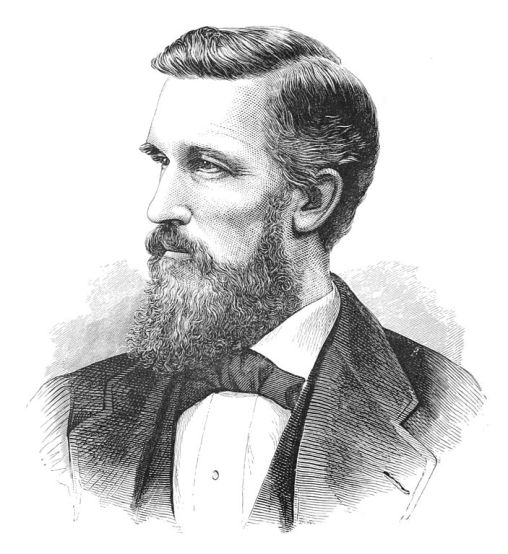
By 1870 he was partner in an electrical equipment manufacturer, of which Gray was the electrician (i.e., chief engineer). In 1872 he and his partner moved their operation to Chicago and renamed it the Western Electric Manufacturing Company. Western Electric soon became Western Union’s primary source for telegraphic equipment, and would become a name of some significance in the history of the telephone.
Early in 1874, Gray heard a strange sound coming from his bathroom. It sounded like the whine of a vibrating rheotome, only greatly amplified. The rheotome (literally ‘flow-cutter’) was a well-known electrical device that used a metal reed to rapidly open and close a circuit. When he looked into the bathroom, Gray found his son holding an induction coil connected to a rheotome in one hand, and rubbing his other hand against the zinc lining of the bathtub, which was humming with the same frequency. Gray, intrigued by the possibilities, withdrew from the day-to-day duties of Western Electric to spend his time again on invention. By the summer he had developed a full-octave musical telegraph, with which one could play tones on a diaphragm made from a metal washbin by pressing keys on a keyboard.12
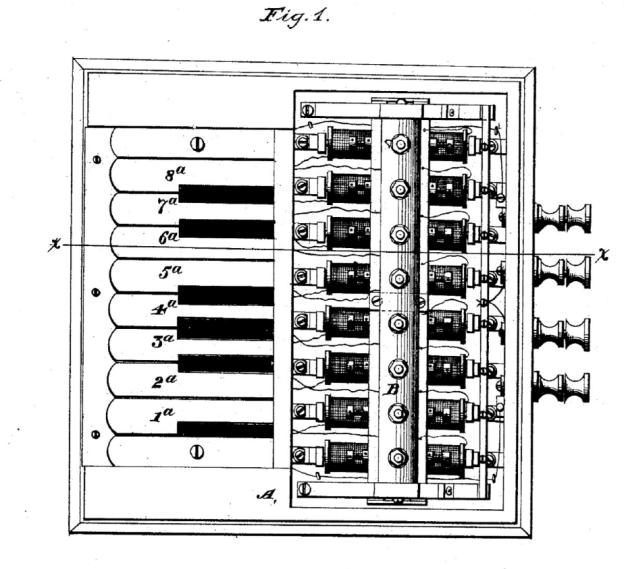
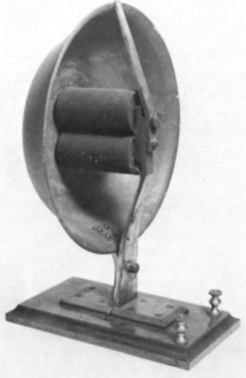
The musical telegraph was a novelty with no obvious commercial value. But Gray realized that the ability to pass multiple tones through a single wire opened two other possibilities to him. With a different transmitter that could capture sounds from the air, he could make a voice telegraph. With a different receiver that could disentangle the combined signal back into its composite tones, he could make a harmonic telegraph – i.e. a multiple telegraph based on sound. The latter was the obvious choice for Gray to focus on, given the clear demand from the telegraphy industry. This instinct was only confirmed in him when Gray learned about the Reis telephone, which had proved, as it seemed, a mere philosophical toy.13
For his harmonic telegraph receiver, Gray constructed a series of electromagnets, each abutting a metal strip. Each strip was tuned to respond to a given frequency, so that it would sound when the corresponding key was pressed on the transmitter. The transmitter operated on essentially the same principle as that used in the musical telegraph.
Gray refined his apparatus over the next two years, and brought it to the great celebration of the nation’s first 100 years, the Centennial Exhibition in Philadelphia in the summer of 1876. There he demonstrated an ‘octruplex’ connection (i.e. eight simultaneous messages) on a specially prepared telegraph line to New York. This accomplishment received high praise from the exhibition judges, but was soon overshadowed by a greater marvel.
Edison
It did not take long for William Orton, Western Union’s president, to get wind of Gray’s progress, and it made him very nervous indeed. The best case, were Gray successful, would be a very expensive patent licensing deal. In the worst case, a Gray patent would form the basis for a rival company that would overthrow Western Union’s dominion.
So in July 1875, Orton called on his ace in the hole, Thomas Edison. Edison had grown up with telegraphy, spending several years as a telegraph operator before striking off on his own as a inventor. He had created his greatest triumph to date, the quadruplex, while on retainer with Western Union the year before. Now Orton hoped he could go one better, and leapfrog whatever Gray had accomplished. He supplied Edison with a description of Reis’ telephone, and Edison also pored over Helmholtz’s Sensations of Tone, newly translated into English.14
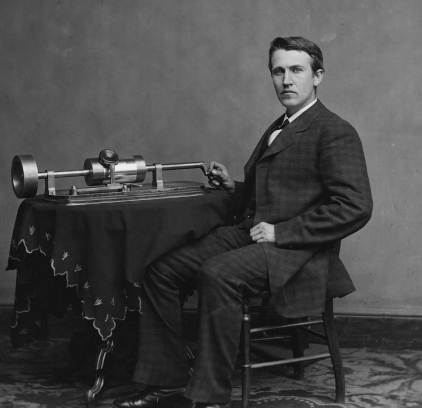
Edison was then in his prime, and threw off inventive ideas as he worked like sparks from an anvil. Over the course of the next year he came up with two different approaches to acoustic telegraphy – the first, similar to Gray’s, used either tuning forks or tuned vibrating reeds to generate and pick up each frequency. Edison never got this to work in a satisfactory manner.
The second approach, which Edison called “acoustic transfer,” was entirely different. Rather than using the vibrating reeds to transmit different frequencies, he used them to transmit at different frequencies, that is to say, at different intervals. He divided the use of the wire among the senders by time rather than by frequency. This required perfect synchronization of the vibrations in each sender/receiver pair, to prevent the signals from overlapping. By August 1876 he had an octruplex working on this principle, though the signal became unusable beyond 100 miles. He also had some ideas about how to improve Reis’ telephone, which he set aside for the time being.15
Then Edison heard about the sensation created at the Philadelphia Centennial Exhibition by a man named Bell.
Bell
Alexander Graham Bell was born in Edinburgh, Scotland, and came of age in London, under the tutelage of his grandfather. Like Gray and Edison, he developed a boyhood interest in telegraphy, but, like his father and grandfather before him, he found his true passion in the domain of human speech. Grandfather Alexander made his name on the stage, then became a teacher of elocution. Father Alexander Melville also taught, and went so far as to develop and publish a system of phonetics which he dubbed Visible Speech. The youngest Alexander (or Aleck, as his family called him) found his particular metier in teaching the deaf to speak.
By the late 1860s he was pursuing courses in anatomy and physiology at University College, London, as well as a young woman, Marie Eccleston, whom he hoped to marry. But he then left behind both learning and love. Both his brothers had died of tuberculosis, and Aleck’s father requested that he emigrate with the remaining family to the New World, in order to preserve the health of his only surviving son. Bell yielded and set sail in 1870 with reluctance and lasting resentment.16
After a brief stint in Ontario, Alexander found, through his father’s influence, a position at a deaf school in Boston. There lay the threads of his future life, waiting to be plucked.
First was a girl, Mabel Hubbard, who had lost her hearing at the age of 5 during a bout of scarlet fever. Even after becoming Professor of Vocal Physiology and Elocution at Boston University, Bell took on private pupils for additional income, and Mabel was among his first. She was then just shy of 16, ten years younger than Bell, but within months he had fallen for her. We shall return to this young woman momentarily.17
Sometime in 1872, Bell had also renewed his interest in telegraphy. Several years before, while still in London, Bell had learned about Helmholtz’s experiments. Bell was confused at the time about what Helmholtz had actually done, believing he had not only generated but transmitted complex sounds electrically. So Bell, too, conceived the germ of harmonic telegraphy – that a wire could be shared by several signals by sending them at different frequencies. Perhaps inspired by the news that Western Union had acquired the duplex invention of Joseph Stearns, a fellow Bostonian, Bell now revived this idea, and, like Edison and Gray, began striving to make it reality.18
One day, while visiting Mabel’s home, he touched a second thread of fate, for while standing by the piano, he taught her family a trick he had learned in his youth. If you sing a pure note into a piano, he showed them, the corresponding wire will hum and play the note back to you. He mentioned to Mabel’s father that a tuned telegraphic signal could do the same, and explained how this could be used for multiple telegraphy. Bell could not have found a listener more attuned to these words. He resonated with excitement, and immediately grasped the crucial insight: “there is only one air and so there need be but one wire“, i.e. the undulations of the current in the wire could, in miniature, represent all the undulations of air caused by a complex sound. That listener was, of course, Gardiner Hubbard.19
Telephone
Here the story gets very complicated, and I fear to try my reader’s patience. I will try to trace the key threads without getting mired in detail.
Bell, now backed by Hubbard and the father of another of his students, worked sedulously and in secret on his harmonic telegraph. He alternated bouts of furious work with periods of rest when his health failed him, while still trying to keep up with his duties at the university, the promotion of his father’s system of Visible Speech, and his tutoring of private students. He also acquired a new assistant, Thomas Watson, a skilled mechanic in the Boston shop of Charles Williams, the hub of the local electrical community 20. Hubbard drove Bell on, and did not scruple to use his daughter’s hand as a goad, going so far as to refuse the possibility of marriage until Bell perfected his telegraph.
In the summer of 1874, however, while relaxing near his family’s home in Ontario, Bell had a revelation. Several notions that had been percolating in the back of his mind now flowed together into a new creation – a telephone. Among the important influences on his thought was the phonautograph, a device that used a cadaver ear (really) to trace sound waves on smoked glass. This gave Bell the conviction that sounds of arbitrary complexity could be reduced to a point moving through space, like current moving through a wire. The technical details need not detain us here, since they bear no relation to any telephonic device ever built, or that was ever likely to be practical. But they set Bell’s mind off in a new direction.21
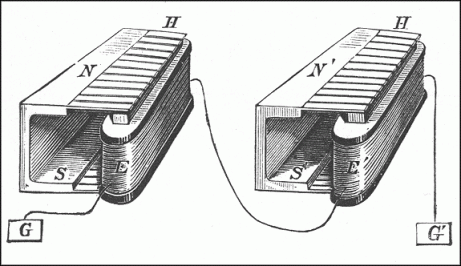
Bell set aside the idea for a time, pressing on with the harmonic telegraph as his partners expected.
But he grew tired of the grind of tweaking his instruments; wearied of the many obstacles between a proof of concept and practical system, and more and more his heart was drawn to the telephone. The human voice, his first passion. In the summer of 1875, he discovered that he could use his vibrating reeds not just to open and close a circuit rapidly like a telegraph key, but, when moved within a magnetic field, to actually to generate a continuous undulatory current. He told Watson about his ideas for telephony, and together they built their first telephone model on this principle -a diaphragm that, when vibrating in the field of an electromagnet, produced an undulatory current in the magnet’s circuit. This device managed to transmit some kind of muffled vocal sounds. Hubbard, unimpressed, told Bell to return to the real work.22
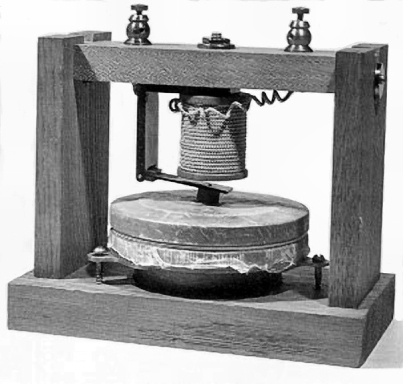
Bell did, however, convince Hubbard and his other partners that the undulatory current idea was worthy of patent, and could be of use in multiple telegraphy. As long as the patent was being filed, there was no reason not to mention that, by the way, it could be used for voice communication, too. Then, in January, Bell added to the draft patent a new mechanism for generating the undulatory current: variable resistance. His idea was to attach the vibrating diaphragm that received the sound to a platinum lead that dipped in and out of a cup of acid which contained a second, fixed lead. When the moving lead dipped deeper, more surface area would be in contact with the fluid, decreasing the resistance of the current flowing between the two leads, and vice versa.23
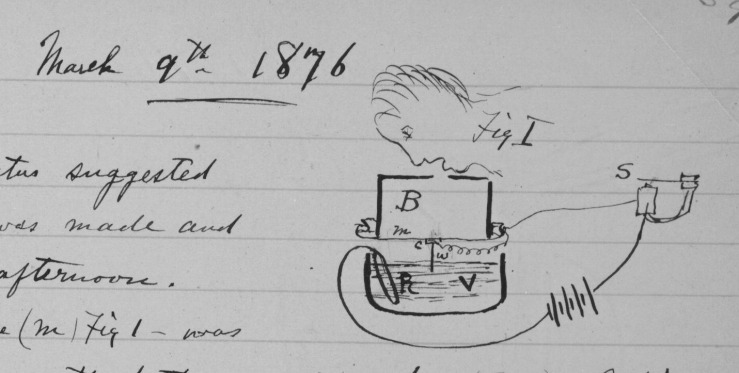
The high drama of this moment overlays a deep irony, however. For neither Bell nor Gray had actually built a working telephone as of February 14, 1876. Neither had even tried, other than Bell’s brief attempt the previous July, which did not involve variable resistance transmission at all. This should warn us of the danger in giving undue weight to patents as milestones in the history of technology. This crucial moment for the telephone as a business concern had almost nothing to do with the telephone as a device.
Only after filing the patent did Bell and Watson have time to return to dabbling with the telephone, in defiance of Hubbard’s continued insistence that they remain focused on multiple telegraphy. Bell and Watson tried for several months to get his liquid variable resistance idea to work, and a telephone built on that principle was used to convey the famous sentence, “Mr. Watson, come here, I want to see you.”26
But the two men ran into constant problems with the reliability of these transmitters. So instead Bell had Watson build new transmitters using the magneto principle that they had experimented with back in the summer of 1875 – using the movement of the diaphragm in a magnetic field to induce the undulating current directly.27 This had the major advantage of reliability and simplicity. But the major disadvantage that the strength (or lack thereof) of the telephone signal derived directly from the vibrations of the air created by the speaker’s voice. This put a sharp limit on the effective range of the magneto transmitter. In contrast, in the variable resistance device the speaker’s voice modulates a battery-generated current, which can have whatever strength desired.
The new magneto devices worked much better than those of the previous summer, and convinced Gardiner that there might be something to the telephone after all. Among his many activities, he sat on the committee for the Massachusetts education and science exhibit at the upcoming Centennial Exhibition. He used his influence there to get Bell a slot on the exhibition floor, and on the schedule of the judges evaluating electrical inventions.
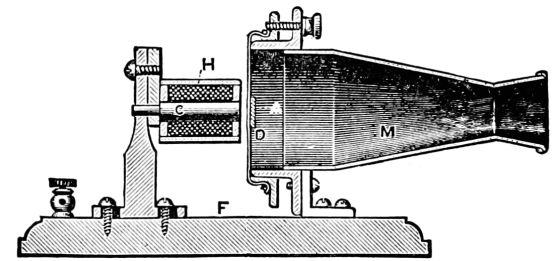
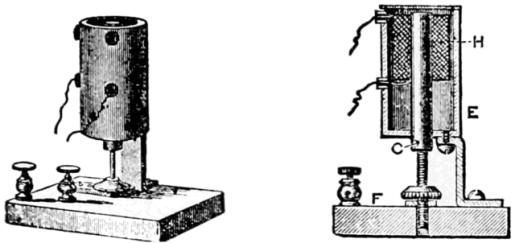
The judges arrived at Bell’s exhibit just after examining Gray’s harmonic telegraph. He left the judges at the receiver and retired to one of his magneto transmitters, one hundred yards across the gallery. Bell’s interlocutors were amazed to hear his songs and words emerge from the little iron box. One of the judges was Bell’s fellow Scotsman, William Thompson (later dubbed Lord Kelvin), who ran with excitement across the hall to tell Bell that he had heard his words, and later declared the telephone “the most wonderful thing he has seen in America.” The Emperor of Brazil was also present, and pressed his ear to the box, then leaped up from his chair to exclaim, “I hear, I hear!”28
The splash that Bell made at the Centennial galvanized Edison into acting on his previously vague ideas for telephonic transmission. He immediately attacked the glaring weakness in Bell’s device: the feeble magneto transmitter. He knew from his work with the quadruplex that the resistance of carbon granules varied with pressure. After a great deal of experimentation with different configurations, he developed a variable resistance transmitter based on this fact. Instead of moving a metal lead in a liquid, the pressure waves of the speaker’s voice compressed a carbon “button”, altering its resistance and thus the strength of the current in the circuit. This was much simpler, more reliable, and easier to maintain then the liquid transmitters conceived by Bell and Gray, and was a vital contribution to the long-term success of the telephone.29
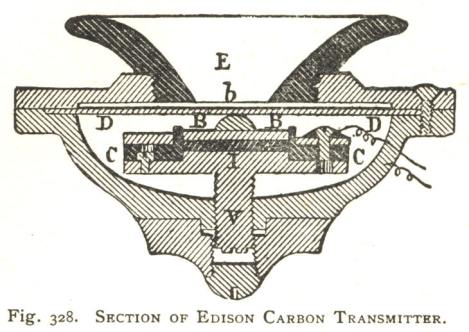
Yet Bell arrived first at the telephone, despite the obvious advantages, in skill and experience as electrical inventors, held by his rivals. He arrived first, not because he had any special insight that they had missed – both thought of the telephone, but they thought it insignificant compared to the opportunities available to pursue an improved telegraph. Bell arrived first because he cared more about the human voice than about telegraphy, cared enough to defy the will of his partners until he could prove that his telephone would work.
What of the harmonic telegraph, on which Gray, Edison and Bell had expended so much effort and ingenuity? Nothing would come of it, yet. Keeping mechanical vibrators on both ends of the wire in perfect tune with one another proved extremely hard, and no one knew how to amplify the combined signal to work over longer distances. Not until well into the twentieth century, after electronic technology that originated with radio allowed precise, unwavering frequency tuning and low-noise amplification, did the idea of overlaying many signals on a single wire come to fruition.30
Farewell to Bell
Despite the success of the telephone at the Centennial, Hubbard was still not terribly interested in building a telephone system. Sometime during the following winter, he offered William Orton, Western Union’s president, all of the rights to the telephone as embodied in Bell’s patents for $100,000. Motivated by some combination of distaste for Hubbard and his postal telegraph schemes, confidence in his own resources and Edison’s ongoing work on the telephone, and belief that the telephone was of scant importance next to the telegraph, Orton refused. Other attempts by Hubbard to sell were similarly rejected, in large part for fear of the inevitable and costly patent litigation that would follow commercialization.31 Therefore in July 1877, Bell and his partners formed the Bell Telephone Company to begin establishing telephone service themselves. That same month Bell finally married young Mabel Gardiner at her family home, having achieved success enough to win her father’s blessing.
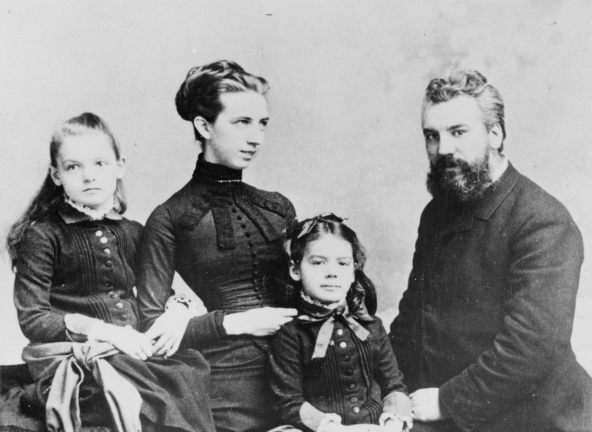
Sometime during the following year, Orton changed his mind about the prospects of the telephone, and formed his own company, the American Speaking Telephone Company, counting on patents from Edison, Gray and others to protect the company from legal action by Bell. This was a mortal threat to the Bell interests. Western Union had two major advantages. First: its vast reserves of capital. The Bell Company was a capital-hungry business, because it rented its equipment to the customer, who would take many months to pay back its initial cost. Second: access to Edison’s superior transmitter. Anyone who compared it to Bell’s could not help but favor the greater clarity and loudness of the voices it conveyed. The Bell company had no choice but to bring a patent infringement suit against their new rival.
Had Western Union secured unequivocal rights to the only available high-quality transmitter, they might have had powerful leverage in reaching an agreeable settlement. But Bell’s team unearthed an earlier caveat lodged by a German immigrant named Emil Berliner for a similar device, and acquired the rights. It would take many years of legal battle before Edison’s patent was given priority. Seeing that the trial was not going to go its way, in November 1879 Western Union agreed to grant all of its telephone patent rights, equipment, and existing subscribers (some 55,000 of them) to the Bell Telephone Company. All they asked in exchange was for twenty percent of the telephone rental income for the next seventeen years, and that Bell keep its nose out of the telegraph business.32
Like the Morse telegraph, the Bell telephone system was catalyzed, rather than built, by the work of its namesake. The Bell company quickly replaced Bell’s instruments with superior ones based at first on Berliner’s patent and later on patents acquired from Western Union. By the time of the settlement, Bell’s primary duty in the Bell Telephone Company was providing testimony in patent suits, of which there were many. By 1881 he withdrew from the business entirely. Like Morse, and unlike Edison, he was no system builder. Theodore Vail, a managerial dynamo recruited by Gardiner from the Post Office, took charge of the company and oversaw its rise to national dominance.
The initial pattern of growth of the telephone network was very different from the telegraph’s. The latter leaped from one commercial hub to the next in bounds of 100 miles or more, seeking the highest concentrations of high value customers, and only later filling out the network with connections to smaller local markets. Telephone networks, on the other hand, grew like crystals from tiny local seeds, a handful of customers in independent clusters in each town and neighborhood that gradually, over decades, interconnected into regional and national structures.
There were two reasons for this, two obstacles to larger-scale telephony. First was the problem of distance. Even with the stronger variable resistance transmitters descended from Edison’s, there was no comparison between the reach of the telegraph and telephone. The far more complex signal of the telephone made it much more susceptible to noise, and the electrical properties of its fluctuating currents were much less well understood than those of the direct currents used in telegraphy.
Second was the problem of connection. The telephone as designed by Bell was, like the telegraph, a one-to-one device, it could only directly connect two endpoints along a single wire. For the telegraph this was not a serious problem. A single office could serve many customers and messages could easily be forwarded from a central office down another line. One could not easily ‘forward’ a telephone conversation, however. In the first instance, the only way that a 3rd or later subscriber could talk to two existing ones was to join what was later called a “party line.” That is to say, a single wire with all the subscribers’ instruments attached to it, so that anyone could talk to (or eavesdrop on) anyone else.
We’ll return to the problem of distance in due time. In our next installment, we will delve into the problem of connection and its consequences for the switch. [Next Part]
Further Reading
Robert V. Bruce, Bell: Alexander Graham Bell and the Conquest of Solitude (1973)
David A. Hounshell, “Elisha Gray and the Telephone: On the Disadvantages of Being an Expert”, Technology and Culture (1975).
Paul Israel, Edison: A Life of Invention (1998)
George B. Prescott, The Speaking Telephone, Talking Phonograph, and Other Novelties (1878)
- C.G. Page, “The Production of Galvanic Music,” The American Journal of Science and Arts (1837). The effect is now known as magnetostriction. ↩
- George B. Prescott, The Speaking Telephone, Talking Phonograph, and Other Novelties (1878), 55-56. James Joule made a thorough quantitative investigation of the matter to determine if it might be used to make an electric engine, but concluded that the effect was far too weak. J.P. Joule, “On the Effects of Magnetism upon the Dimension of Iron and Steel Bars”, The London, Edinburgh and Dublin Philosophical Magazine (1847). ↩
- Anton A. Huurdeman, The Worldwide History of Telecommunications (2003), 154-156; Alvin F. Harlow, Old Wires and New Waves (1936), 344-348. ↩
- It’s probable that the platinum contacts and spring of the Reis telephone could sometimes act as a modulator (rather than a rheotome, breaking the circuit), if they were poorly tuned and/or dirty, causing the contacts to not fully separate, and thus inadvertently creating an undulating current (as the surface area of contact varied with the vibration). This may explain some of the reports of articulate speech transmitted by a Reis device. ↩
- Silvanus P. Thompson, Philipp Reis: Inventor of the Telephone (1883). ↩
- David Pantalony, Altered Sensations: Rudolph Koenig’s Acoustical Workshop in Nineteenth-Century Paris (2009), 52. ↩
- Bruce, Bell, 50-51. ↩
- John Bray, Innovation and the Communications Revolution (2002), 38. ↩
- Alexander Graham Bell quoted in Robert V. Bruce, Bell: Alexander Graham Bell and the Conquest of Solitude (1973), 137. ↩
- Richard R. John, Network Nation (2010), 126-128. ↩
- National Museum of American History, “Gray Telegraph Relay Patent Model” ↩
- Bruce, Bell, 113-116. ↩
- David A. Hounshell, “Elisha Gray and the Telephone: On the Disadvantages of Being an Expert”, Technology and Culture (1975), 144-148. ↩
- Paul Israel, Edison: A Life of Invention (1998), 108-110. I have elided the details of the story of the quadruplex for simplicity – there were extensive negotiations and legal battles between Edison, Western Union, and Jay Gould’s Atlantic and Pacific telegraph company over the rights, before the issue was finally settled by Western Union’s acquisition of Atlantic and Pacific. See Thomas A. Edison Papers, Chronology: 1847-1878. ↩
- Israel, Edison, 115-118, 124-127. ↩
- Bruce, Bell, 65-69. ↩
- Bruce, Bell, 100, 120. ↩
- Bruce, Bell, 93-94 ↩
- Bruce, Bell, 126. ↩
- Bruce, Bell 132-133. Edison had also worked with craftsmen at the Charles Williams shop, during his stint in Boston. During the early days of the Bell Company, the shop was the sole source of all Bell telephone equipment. ↩
- Bruce, Bell, 120-22. ↩
- Bruce, Bell, 144-145. ↩
- Bruce, Bell, 163-164. ↩
- Some have inferred from this coincidence that one of the men must have “stolen” the idea from the other. The evidence adduced for this in either direction appears to me feeble, and to amount to little more than innuendo. ↩
- Bruce, Bell, 168-172. ↩
- Bruce, Bell, 180-181. Unfortunately Bell did not have the opportunity to prepare a suitably portentous phrase such as “What hath God wrought.” We are unlikely to see a sweeping history of the United States in the nineteenth century entitled Mr. Watson, Come Here, I Want to See You. ↩
- Bruce, Bell, 187. ↩
- Bruce, Bell, 195-197. ↩
- Bruce, Bell, 229-230. ↩
- Bruce, Bell, 212. ↩
- Bruce, Bell, 229; John, Network Nation, 163. ↩
- Bruce, Bell, 270-271. ↩
